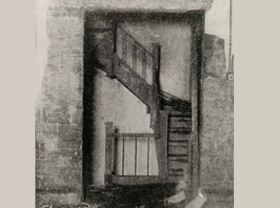EIGHTH
Part One, Chapter Three (excerpt), page 37
Flames crept nearer to her desk, but Dinah Lifschitz held her post. On her desk was a telephone and a telautograph-a duplicating scriptwriter for sending messages-that had recently been installed by the firm. Both connected directly with the executive offices on the tenth floor.
"I right away sent a message to the tenth floor on the telautograph," Dinah said. "But they apparently didn't get the message because I didn't get an answer.
"Then I used the telephone. I called the tenth floor and I heard Mary Alter's voice on the other end. I told her there was a fire on the eighth floor, to tell Mr. Blanck. 'All right, all right,' she answered me."
Dinah stayed at the phone. She shouted to the switchboard operator to connect with the ninth floor. She was getting no answer.
But her call had given the alarm to the people on the tenth floor. They began to ring for the passenger elevators, and the operators responded to the buzzing from the executive floor. The cars began to pass the eighth floor.
The girls crushed against the eighth floor elevator doors could see the cars going up. "Some of the girls were clawing at the elevator doors and crying, 'Stop! Stop! For God's sake stop,' " Irene Seivos remembered.
"I broke the window of the elevator door with my hands and screamed, 'fire! fire! fire!' It was so hot we could scarcely breathe. When the elevator did stop and the door opened at last, my dress was catching fire."
The car could not hold all who tried to crowd in. Irene Seivos jumped on top of the girls already in the car just as she saw the door closing. Someone grabbed her long hair and tried to pull her out, but she kicked free and rode to safety.
One of those on whom she landed was Celia Saltz. When the fire had started, she was still at her machine. "All I could think was that I must run to the door. I didn't know there was a fire escape. I even forgot that I had a younger sister working with me.
"The door to the staircase wouldn't open. We pushed to the passenger elevators. Everybody was pushing and screaming. When the car stopped at our floor I was pushed into it by the crowd. I began to scream for my sister. I had lost her, I had lost my sister."
Celia fainted in the car, but in the crush remained on her feet. When she regained consciousness she was stretched out on the floor of a store across the street from the Asch building. "I opened my eyes and I saw my sister bending over me. I began to cry; I couldn't help it. My sister, Minnie, was only fourteen."
While one group of terrified girls struggled to get into the elevators, another small crowd fought to get through the Washington Place stairway door. Some ran from the elevator to the door. Then back again.
Josephine Nicolosi recalls that when she reached the door to the stairs some thirty girls were there. "They were trying to open the door with all their might, but they couldn't open it. We were all hollering. We didn't know what to do. Then Louis Brown hollered, 'Wait, girls, I will open the door for you!' We all tried to get to one side to let him pass."
Crushed against the door was Ida Willinsky, exerting all of her strength in a futile effort to push the crowd back. "All the girls were falling on me and they squeezed me to the door. Three times I said to the girls, 'Please, girls, let me open the door. Please!'
"But they did not listen to me. I tried to keep my head away from the glass in the door. Then Mr. Brown came and began to push the girls to the side."
Brown remembered that when he reached the area of the door he found all the girls screaming. "I tried to get through the crowd. I pushed my way through and tried by main strength to scatter them. But they were so frantic they wouldn't let me through. As I tried to push them to the side, they pushed back. At such a time, a thousand and one thoughts go through your mind. All I could think was 'Why don't they let me through? Why don't they understand that I am trying to get them out?'
"I finally got to the door. There was a key always sticking in that door and I naturally thought that they must have locked the door. So I turned, all I tried to do was to turn the key in the lock. But the key wouldn't turn to unlock the door. It did not turn. So I pulled the door open. It didn't open right away.
"I had to push the girls away from the door. I couldn't open it otherwise. They were packed there by the door, you couldn't get them any tighter. I pulled with all my strength. The door was open a little while I was pulling. But they were all against the door and while I was pulling to open it they were pushing against it as they tried to get out.
"They were closing the door by their pushing and I had to pull with all my might to get it open."
Brown finally got the door open, and the screaming girls squeezed themselves into the narrow, spiral staircase, pushing and falling in their fright. Brown tried to calm them as he stood at the door.
Leon Stein, The Triangle Fire (New York: A Carroll & Graf/Quicksilver Book, 1962), pp. 37-39.
The Kheel Center would like to thank Mrs. Miriam Stein and Barbara Ismail for granting permission to use selections from the late Leon Stein's book.

